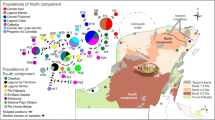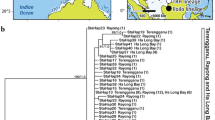Abstract
The population genetics and historical demography of the swimming crab Callinectes bellicosus from the eastern Pacific were assessed using mitochondrial DNA (mtDNA) sequences from portions of the cytochrome c oxidase subunit I (COI) and cytochrome b (Cytb) genes. Analysis of molecular variance of sequence data from crabs collected from nine localities, ranging from the upper to lower Gulf of California and the outer coast of the Baja California peninsula, revealed an absence of population structure, suggesting a high level of gene flow over a wide geographic area. Maximum-likelihood estimates of long-term effective population size obtained with the program FLUCTUATE, in addition to highly significant values obtained from neutrality tests (Tajima’s D, Fu and Li’s D, and Fu’s FS) and mismatch analysis, are consistent with a population expansion dating to the Pleistocene epoch. Phylogenetic analysis of C. bellicosus sequences using both neighbor-joining and Bayesian methods revealed a widely distributed subclade (clade II) cryptically embedded at low frequency in the main (clade I) population. Although sequence divergence between the two clades was low (1.1% COI; 0.6% Cytb), statistical support for the split was high. The Kimura-2-parameter genetic distance between C. bellicosus and the sympatric and morphologically similar C. arcuatus was high (d=0.17) and similar to the genetic distance between C. bellicosus and the allopatric C. sapidus from the western Atlantic (d=0.18), suggesting an ancient (Miocene) divergence of C. bellicosus and C. arcuatus.


Similar content being viewed by others
References
Aubert H, Lightner DV (2000) Identification of genetic populations of the Pacific blue shrimp Penaeus stylirostris of the Gulf of California, Mexico. Mar Biol 137:875–885
Bourillón-Moreno L (2002) Exclusive fishing zone as a strategy for managing fishery resources by the Seri Indians, Gulf of California, Mexico. PhD dissertation, University of Arizona, Tucson
Brower AVZ (1994) Rapid morphological radiation and convergence among races of the butterfly Heliconius erato inferred from patterns of mitochondrial DNA evolution. Proc Natl Acad Sci USA 91:6491–6495
Brusca RC (1980) Common intertidal invertebrates of the Gulf of California, 2nd edn. University of Arizona Press, Tucson
Burton RS, Feldman MW (1982) Population genetics of coastal and estuarine invertebrates: Does larval behavior influence population structure? In: Kennedy VS (ed) Estuarine comparisons. Academic, New York, pp 537–551
Chu KH, Tong J, Chan T-Y (1999) Mitochondrial cytochrome oxidase I sequence divergence in some Chinese species of Charybdis (Crustacea: Decapoda: Portunidae). Biochem Syst Ecol 27:461–468
Coates AG, Jackson JBC, Collins LS, Cronin TM, Dowsett HJ, Bybell LM, Jung P, Obando JA (1992) Closure of the Isthmus of Panama: the near-shore marine record of Costa Rica and western Panama. Geol Soc Am Bull 104:814–828
Cole MA, Morgan II RP (1978) Genetic variation in two populations of blue crab, Callinectes sapidus. Estuaries 1:202–205
Correa-Sandoval F, Carvacho-Bravo A (1992) Efecto de la “Barrera de las Islas” en la distribución de los braquiuros (Crustacea: Decapoda) en el Golfo de California. Proc S Diego Soc Nat Hist 26:1–4
Daniels SR, Stewart BA, Gouws G, Cunningham M, Matthee CA (2002) Phylogenetic relationships of the southern African freshwater crab fauna (Decapoda: Potamonautidae: Potamonautes) derived from multiple data sets reveal biogeographic patterning. Mol Phylogenet Evol 25:511–523
de la Rosa-Vélez J, Escobar-Fernández R, Correa F, Maqueda-Cornejo M, de la Torre-Cueto J (2000) Genetic structure of two commercial penaeids (Penaeus californiensis and P. stylirostris) from the Gulf of California, as revealed by allozyme variation. Fish Bull (Wash DC) 98:674–683
Dittel AI, Epifanio CE (1984) Growth and development of the portunid crab Callinectes arcuatus Ordway: zoeae, megalopae, and juveniles. J Crustac Biol 4:491–494
Felsenstein J (1985) Confidence limits on phylogenies: an approach using the bootstrap. Evolution 39:783–791
Folmer O, Black M, Hoeh W, Lutz R, Vrijenhoek R (1994) DNA primers for amplification of mitochondrial cytochrome c oxidase subunit I from diverse metazoan invertebrates. Mol Mar Biol Biotechnol 3:294–299
Fu Y-X (1997) Statistical tests of neutrality of mutations against population growth, hitchhiking and background selection. Genetics 147:915–925
Fu Y-X, Li W-H (1993) Statistical tests of neutrality of mutations. Genetics 133:693–709
Garrigan D, Marsh PC, Dowling TE (2002) Long-term effective population size of three endangered Colorado River fishes. Anim Conserv 5:95–102
Gopurenko D, Hughes JM, Keenan CP (1999) Mitochondrial DNA evidence for rapid colonisation of the Indo-West Pacific by the mudcrab Scylla serrata. Mar Biol 134:227–233
Hamm DE, Burton RS (2000) Population genetics of black abalone, Haliotis cracherodii, along the central California coast. J Exp Mar Biol Ecol 254:235–247
Haq BU, Hardenbol J, Vail PR (1987) Chronology of fluctuating sea levels since the Triassic. Science 235:1156–1167
Harpending H (1994) Signature of ancient population growth in a low-resolution mitochondrial DNA mismatch distribution. Hum Biol 66:591–600
Harrison MK, Crespi BJ (1999) Phylogenetics of Cancer crabs (Crustacea: Decapoda: Brachyura). Mol Phylogenet Evol 12:186–199
Hickerson MJ, Cunningham CW (2000) Dramatic mitochondrial gene rearrangements in the hermit crab Pagurus longicarpus (Crustacea, Anomura). Mol Biol Evol 17:639–644
Holt JW, Holt EW, Stock JM (2000) An age constraint on Gulf of California rifting from the Santa Rosalía basin, Baja California Sur, Mexico. Geol Soc Am Bull 112:540–549
Huelsenbeck JP, Ronquist F (2001) MrBayes: Bayesian inference of phylogeny. Bioinformatics 17:754–755
Kimura M (1980) A simple method for estimating evolutionary rate of base substitutions through comparative studies of nucleotide sequences. J Mol Evol 16:111–120
Knowlton N, Keller BD (1986) Larvae which fall far short of their potential: highly localized recruitment in an alpheid shrimp with extended larval development. Bull Mar Sci 39:213–223
Knowlton N, Weigt LA, Solórzano LA, Mills DK, Bermingham E (1993) Divergence in proteins, mitochondrial DNA, and reproductive compatibility across the Isthmus of Panama. Science 260:1629–1632
Kordos LM, Burton RS (1993) Genetic differentiation of Texas Gulf Coast populations of the blue crab Callinectes sapidus. Mar Biol 117:227–233
Kuhner MK, Yamato J, Felsenstein J (1998) Maximum likelihood estimation of population growth rates based on the coalescent. Genetics 149:429–434
Kumar S, Tamura K, Jakobsen IB, Nei M (2001) MEGA 2: molecular evolutionary genetics analysis software. Arizona State University, Tempe
Luttikhuizen PC, Drent J, Van Delden W, Piersma T (2003) Spatially structured genetic variation in a broadcast spawning bivalve: quantitative vs. molecular traits. J Evol Biol 16:260–272
Marko PB (2002) Fossil calibration of molecular clocks and the divergence times of geminate species pairs separated by the Isthmus of Panama. Mol Biol Evol 19:2005–2021
McCartney M, Keller G, Lessios HA (2000) Dispersal barriers in tropical oceans and speciation in Atlantic and eastern Pacific sea urchins of the genus Echinometra. Mol Ecol 9:1391–1400
McMillen-Jackson AL, Bert TM (2003) Disparate patterns of population genetic structure and population history in two sympatric penaeid shrimp species (Farfantepenaeus aztecus and Litopenaeus setiferus) in the eastern United States. Mol Ecol 12:2895–2905
McMillen-Jackson AL, Bert TM (2004) Mitochondrial DNA variation and population genetic structure of the blue crab Callinectes sapidus in the eastern United States. Mar Biol (in press). DOI 10.1007/s00227-004-1353-3
McMillen-Jackson AL, Bert TM, Steele P (1994) Population genetics of the blue crab, Callinectes sapidus: modest population structuring in a background of high gene flow. Mar Biol 118:53–65
Merritt TJ, Shi L, Chase MC, Rex MA, Etter RJ, Quattro JM (1998) Universal cytochrome b primers facilitate intraspecific studies in molluscan taxa. Mol Mar Biol Biotechnol 7:7–11
Molina RE (1999) La pesquería de jaiba en la costa de Sonora. Pesca Conserv 3:6–8
Norse EA, Estevez M (1977) Studies on portunid crabs from the eastern Pacific. I. Zonation along environmental stress gradients from the coast of Colombia. Mar Biol 40:365–373
Palumbi SR (1994) Genetic divergence, reproductive isolation, and marine speciation. Annu Rev Ecol Syst 25:547–572
Paul RKG (1982a) Observations on the ecology and distribution of swimming crabs of the genus Callinectes (Decapoda, Brachyura, Portunidae) in the Gulf of California, Mexico. Crustaceana 42:96–100
Paul RKG (1982b) Abundance, breeding and growth of Callinectes arcuatus Ordway and Callinectes toxotes Ordway (Decapoda, Brachyura, Portunidae) in a lagoon system on the Mexican Pacific coast. Estuar Coast Shelf Sci 14:13–26
Ramos-Onsins SE, Rozas J (2002) Statistical properties of new neutrality tests against population growth. Mol Biol Evol 19:2092–2100
Reeb CA, Avise JC (1990) A genetic discontinuity in a continuously distributed species: mitochondrial DNA in the American oyster, Crassostrea virginica. Genetics 124:397–406
Riddle BR, Hafner DJ, Alexander LF, Jaeger JR (2000) Cryptic vicariance in the historical assembly of a Baja California peninsular desert biota. Proc Natl Acad Sci USA 97:14438–14443
Rogers AR, Harpending H (1992) Population growth makes waves in the distribution of pairwise genetic differences. Mol Biol Evol 9:552–569
Rozas J, Rozas R (1999) DnaSP version 3: an integrated program for molecular population genetics and molecular evolution analysis. Bioinformatics 15:174–175
Saitou N, Nei M (1987) The neighbor-joining method: a new method for reconstructing phylogenetic trees. Mol Biol Evol 4:406–425
Sánchez-Ortiz CA, Gómez-Gutiérrez J (1992) Distribución y abundancia de los estadios planctónicos de la jaiba Callinectes bellicosus (Decapoda: Portunidae) en el complejo lagunar Bahía Magdalena, B.C.S., México. Rev Investig Cient Univ Auton Baja Calif Sur (Ser Cienc Mar) 3:47–60
Scheltema RS (1986) On dispersal and planktonic larvae of benthic invertebrates: an eclectic overview and summary of problems. Bull Mar Sci 39:290–322
Schneider S, Roessli D, Excoffier L (2000) Arlequin ver. 2.000: a software for population genetics data analysis. Genetics and Biometry Laboratory, University of Geneva, Switzerland
Schubart CD, Diesel R, Hedges SB (1998) Rapid evolution to terrestrial life in Jamaican crabs. Nature 393:363–365
Schubart CD, Conde JE, Carmona-Suárez C, Robles R, Felder DL (2001) Lack of divergence between 16S mtDNA sequences of the swimming crabs Callinectes bocourti and C. maracaiboensis (Brachyura: Portunidae) from Venezuela. Fish Bull (Wash DC) 99:475–481
Stillman JH, Reeb CA (2001) Molecular phylogeny of eastern Pacific porcelain crabs, genera Petrolisthes and Pachycheles, based on the mtDNA 16S rDNA sequence: phylogeographic and systematic implications. Mol Phylogenet Evol 19:236–245
Tajima F (1989) Statistical method for testing the neutral mutation hypothesis by DNA polymorphism. Genetics 123:585–595
Tajima F (1993) Simple methods for testing molecular clock hypothesis. Genetics 135:599–607
Thompson JD, Gibson TJ, Plewniak F, Jeanmougin F, Higgins DG (1997) The ClustalX windows interface: flexible strategies for multiple sequence alignment aided by quality analysis tools. Nucleic Acids Res 24:4876–4882
Watterson GA (1975) On the number of segregating sites in genetical models without recombination. Theor Popul Biol 7:256–276
Williams AB (1974) The swimming crabs of the genus Callinectes. Fish Bull (Wash DC) 72:685–798
Williams ST, Knowlton N (2001) Mitochondrial pseudogenes are pervasive and often insidious in the snapping shrimp genus Alpheus. Mol Biol Evol 18:1484–1493
Zhang D-X, Hewitt GM (1996) Nuclear integrations: challenges for mitochondrial DNA markers. Trends Ecol Evol 11:247–251
Acknowledgements
We thank E. Castañon, O. Morales, E. Ruíz, G. Saad, P. Turk-Boyer and A.H. Weaver for providing samples of eastern Pacific Callinectes, and C. D’Agrosa, D. Rittschof and R. Mayer-Arzuaga for kindly sending samples of C. sapidus from the Atlantic. We also thank L.T. Findley, D. Garrigan, T.A. Markow, M. Mateos, M. Nava, C. Ross, R. C. Vrijenhoek and T. Watts for their help and advice during the course of this study. This research was conducted in compliance with animal care guidelines and was supported in part by the National Science Foundation grant DEB-9510645 to Dr. T.A. Markow, The David and Lucile Packard Foundation and the Gulf of California Programs of the World Wildlife Fund and Conservation International.
Author information
Authors and Affiliations
Corresponding author
Additional information
Communicated by P.W. Sammarco, Chauvin
Rights and permissions
About this article
Cite this article
Pfeiler, E., Hurtado, L.A., Knowles, L.L. et al. Population genetics of the swimming crab Callinectes bellicosus (Brachyura: Portunidae) from the eastern Pacific Ocean. Marine Biology 146, 559–569 (2005). https://doi.org/10.1007/s00227-004-1463-y
Received:
Accepted:
Published:
Issue Date:
DOI: https://doi.org/10.1007/s00227-004-1463-y




